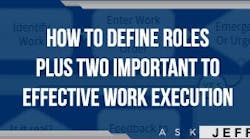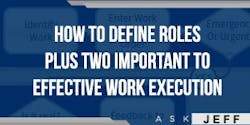Susan, maintenance planner scheduler, South Carolina
Answer: Hello, Susan. Interestingly, your question is not unique, as I have seen many organizations where planner schedulers lacked formal education in the role. I've also trained planner schedulers who had been in their role up to 10 years without previously having received training in it. It is a prevalent problem that many practitioners mistakenly thought was solved. Studies have indicated that fewer than 10% of maintenance planner schedulers are effectively utilized. When we don’t properly define roles and hold people accountable, lots of duplication of activities tends to occur within the organization. As an example, the planner scheduler may quote parts, and then the buyer will turn around and repeats the same process.
We tend to forget that people change roles, and we repeatedly fail to provide:
- Defined business processes in the form of graphical workflows, RACI or RASI documents, and definitions documents. A maintenance processes manual should exist for onboarding people new to the role.
- A document detailing roles and responsibilities for all within the organization, not just for maintenance. Of specific interest to the maintenance planning and scheduling role are the maintenance supervisor, planner scheduler, operations supervisor, storeroom supervisor/clerk, technician, and equipment operator roles. The first four are the most important.
- A list of expectations and accountability measaures for each role.
Let’s answer your question with the typical responsibilities of the maintenance supervisor and planner scheduler.
Maintenance supervisor
The focus is today and this week – a tactical focus. He or she addresses emergency and urgent work that crops up in a given week (because scheduled work was locked up at the end of the previous week) and documents the break-in tasks as "schedule breakers." He or she understands the work that is accomplished by day and assigns new work daily based on priority across a range of priorities. Remember, everyone gets 100% scheduled work, including the reactive technicians. He or she is accountable for the execution of the current (this) week’s schedule and attempts to deliver a minimum of 85%–90% schedule compliance and 95% PM compliance.
This individual also removes obstacles for work in progress, such as by locating parts and materials. To do this, a supervisor should spend two-thirds of the day in the field. Note that finding parts and information for daily work is NOT the responsibility of the planner scheduler. The supervisor attends daily operations meetings that address the issues of the current week. A supervisor is also responsible for addressing workforce development and cross-training needs.
Working with the planner scheduler, the supervisor determines the available resource hours for the coming weeks and informs the planner scheduler, who, then builds a schedule to that resource amount (ideally, 100% of paid labor resources).
Maintenance planner scheduler
The focus for this individual is next week and beyond – a future strategic focus. He or she forecasts future work from the maintenance backlog by understanding job scopes, researching the jobs, planning the jobs, and preparing job packages. All future work benefits from a level of planning; however, that work may not require a job plan but rather only notes or materials on the work order. The planner scheduler should spend one-third of the day in the field. We want the creation of a backlog of planned work – some ready to schedule and some awaiting materials.
He or she should prepare a full week’s schedule for the coming week as a minimum from the ready-to-schedule backlog. Two weeks in advance is a better forecast. Prepare the schedule with the buy-in of the stakeholders, especially the maintenance supervisors. Work then should be placed on the schedule based on priority and requested by date, with a distribution of high-, medium-, and low-priority work. The planner scheduler identifies the parts requirements and may requisition them. Ideally, the storeroom will buy the parts and materials.
The planner scheduler leads the weekly scheduling meeting, timed to be close to the end of the current week’s schedule period. He or she may also lead a backlog review meeting on a periodic basis. However, I recommend that the planner scheduler NOT attend the daily operations meeting, as I have found this pulls the planner scheduler’s focus into the reactive work of the current week. When that occurs, the planner scheduler lands in the domain of the maintenance supervisor and loses future focus. For the same reason, the planner scheduler should not shag parts or materials for jobs in progress. If we allow these distractions, then we will never have a future focus, and reactivity will prevail.
The planner scheduler typically tracks and reports the key performance indicators. In the weekly scheduling meeting, I look for the reporting of three metrics from the previous week: PM/PdM compliance, schedule compliance, and schedule breakers. The planner scheduler should be expected to produce a minimum of 2–3 detailed job plans per week for the more-complex jobs. Remember that the role of the planner scheduler is not to provide a comprehensive plan that tells the technicians what to do but a plan that is detailed at the appropriate level to ensure precision approaches and the elimination of avoidable delays. We plan and schedule to ensure that the right parts, information, and resources are available at the right time so that we can accomplish more work. Creating an effective job plan is a balancing act that requires an effective feedback loop and partnership among the crafts, planner schedulers, and supervisors.
For the readers, what else would you add? Please post your comments.
Talk soon,
Jeff Shiver, CMRP
If you have questions in the fields of maintenance, reliability, planning and scheduling, MRO storerooms, or leadership as examples, please contact Jeff Shiver with your question(s).


